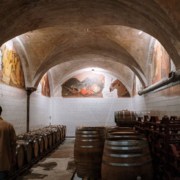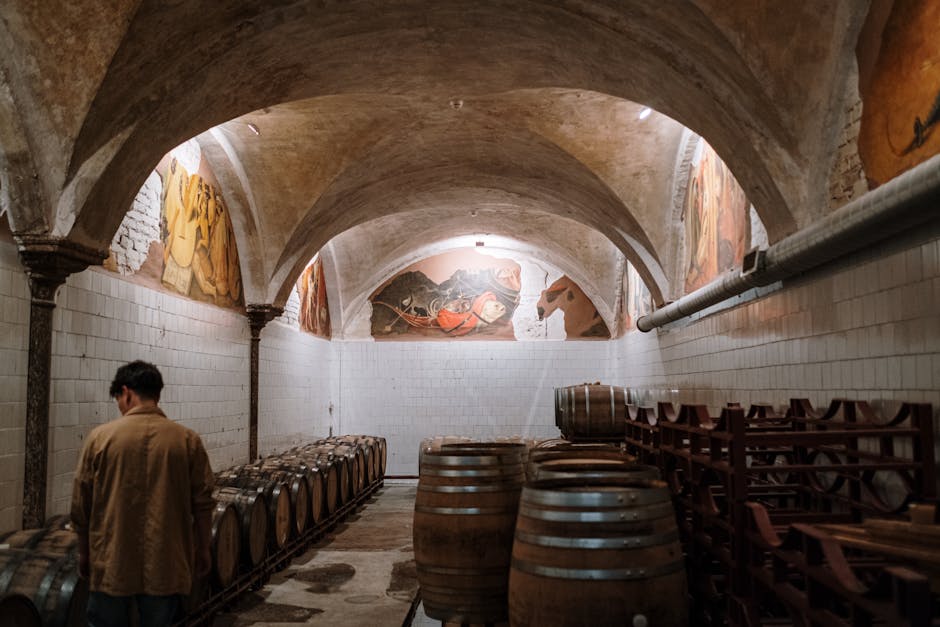The Role of Temperature Control in Wine Cellar Design: Protecting Your Investment
Introduction to Wine Cellar Design and Temperature Importance
When you’re diving into the world of wine collecting, understanding the basics of wine cellar design is a must. And no aspect is more crucial than temperature control. Think of your wine as a living thing. Just like you and me, it thrives under the right conditions and temperature is king. Why, you ask? Because wine is sensitive. Too hot, and it ages too fast, losing its finer traits. Too cold, and its aging slows down too much, robbing you of its potential. The sweet spot? Between 55°F and 58°F with about 70% humidity. This golden range keeps your wine aging perfectly and maintains its cork in prime condition, preventing it from drying out or getting too moist. So, when sketching out your wine cellar, remember, getting the temperature right is not just smart; it’s essential to protect your investment and ensure your wine can be enjoyed at its best.
Understanding the Ideal Wine Storage Conditions
To keep your wine in prime condition, understanding the ideal wine storage conditions is key. Aim to keep your cellar at a consistent temperature, ideally around 55°F (13°C). Fluctuations can harm the wine, causing it to age prematurely. Humidity plays a big role too. Aim for 60-70% humidity to keep the cork from drying out without encouraging mold growth. Light, especially UV rays, can degrade wine over time, so keep your bottles in a dark place. Lastly, keep vibrations to a minimum as they can disturb the sediment in wine, affecting its aging process. By maintaining these conditions, your wine will age gracefully, preserving both taste and value.
Understanding the Ideal Wine Storage Conditions
Temperature is king when it comes to storing wine. Get it right, and your wine ages like a champ, unlocking flavors and complexities that make each sip better than the last. Get it wrong, and you’re looking at a collection of vinegar. So, here’s the scoop: keep your wine cellar at about 55°F (13°C). Why? Because wine is a bit like Goldilocks—not too hot, not too cold. Too hot, and your wine ages too quickly, losing its character. Too cold, and the aging process slows down, robbing you of the magic that time brings to your bottle. Humidity is also part of the equation but let’s save that chat for another day. Remember, consistency is key. Fluctuating temperatures are the enemy, leading to expanded and contracted corks, which can let air in and spoil your wine. In short, stable, cool temperatures ensure your wine ages gracefully, ensuring your investment pays off in taste.
The Basics of Temperature Control in Wine Cellar Design
In wine cellar design, nailing temperature control is key. Picture this: you’re protecting a treasure. Only instead of gold, it’s those bottles of wine you cherish. The ideal temperature range? Keep it between 55 to 58 degrees Fahrenheit, with humidity levels hanging around 60-70%. Stray too hot, and your wine ages too fast. Swing too cold, and you risk turning your cabernets into slushies. So, how do you lock in these conditions? First, invest in a good cooling system. Think of it as the guardian of your liquid gold. This doesn’t just mean slapping in a standard AC unit; you need something built for the long haul, designed specifically for wine cellars. Insulation and a vapor barrier are next. These are your cellar’s armor, protecting against external temperature swings and moisture. Without them, you’re battling an uphill fight. Remember, fine wine is not just a drink. It’s an investment, a piece of history. Treating its storage with the respect it deserves means you get to enjoy its full potential down the line. Bring the right tools to this fight: a solid cooling system, robust insulation, and a vigilant eye on maintaining those numbers. Follow these steps, and your wine collection will be in prime condition for years to come.
Innovative Temperature Control Technologies for Wine Cellars
In the world of wine, temperature is king. It can make or break the quality of your bottles. That’s where innovative temperature control technologies come into play, ensuring your wine cellar protects your investment. First off, there’s the smart thermostat. This gadget adjusts the cellar’s temperature based on real-time conditions. It’s like having a climate expert on standby, making sure your wine stays in its happy place. Next, we’ve got thermal insulation materials. These are the walls’ unsung heroes, maintaining stable conditions, no matter if it’s boiling or freezing outside. Now, don’t forget humidity control systems. Wine hates dryness as much as extremes in temperature. This system keeps the air just moist enough, stopping your corks from drying out and letting oxygen ruin your wine. Also, UV protection is a big deal. LEDs or specially designed lights mimic the soft embrace of a dark cellar, avoiding the harshness of sunlight that can degrade your precious bottles. Finally, for the tech-savvy, there are wine cellar management apps. These apps let you monitor and adjust settings remotely, giving you peace of mind whether you’re at home or away. Gone are the days of guessing and worrying. These technologies ensure your wine ages perfectly, proving that in the battle to safeguard your wine, innovation is your best ally.
Insulation and Cooling Systems: The Backbone of Temperature Regulation
When you’re diving into the wine cellar design, think of insulation and cooling systems as the core muscles. They keep everything stable, ensuring your wine ages perfectly. Without solid insulation, your cellar can’t maintain the ideal temperature, leading to your wine’s premature aging. It’s like building a house without good walls; the outside conditions will always seep in.
Cooling systems, on the other hand, act as your cellar’s personal thermostat. They kick in to cool things down when your cellar gets too warm and ensure it stays at a steady temperature. But here’s the thing – not just any cooling system will do. You need one that’s made for wine cellars, capable of handling the unique needs of your collection.
So, when planning your wine cellar, invest in quality insulation and a proper cooling system. It might seem like a big expense now, but it’s cheaper than replacing a spoiled wine collection. Remember, good insulation plus a top-notch cooling system equals a happy wine collection.
Monitoring and Maintaining the Perfect Climate
The key to keeping your wine in prime condition lies in the control of the cellar’s climate. Think of your wine collection as a long-term investment that thrives under specific conditions. Temperature and humidity are the pillars of these conditions. Ideally, you want your wine cellar to sit at a constant temperature between 55 to 59 degrees Fahrenheit and maintain a humidity level of 60% to 70%. Straying outside these ranges can lead to premature aging or spoilage of your wine.
Why such specific numbers, you ask? Well, the right temperature slows down the wine’s aging process, allowing it to develop flavors and complexity over time. Too hot, and your wine ages too quickly, losing its depth. Too cold, and the aging process is arrested, denying the wine its potential. As for humidity, if it’s too low, corks can dry out, letting air into the bottle and spoiling the wine. Too high, and you risk mold growth, not just on the labels but potentially infiltrating the cork and damaging the wine.
Monitoring these conditions doesn’t have to be a chore. Invest in a good quality temperature and humidity gauge, and consider a climate control system if your cellar’s natural environment isn’t stable. Remember, keeping the climate in check not only protects your wine but can enhance its maturation, turning a good bottle into an extraordinary one over time. So, give your wine the care it deserves, and it will pay off in unmatched flavors and richness.
The Impact of Fluctuating Temperatures on Wine Quality
Temperature matters a lot when it comes to storing wine. Think about it like this – if the temperature swings too much in your wine cellar, it’s not just the flavor of your wine that might change; you’re risking the whole quality of your investment. Ideal storage conditions keep the temperature steady, around 55°F or 13°C. When the temperature goes up and down, it messes with wine’s aging process. Too warm, and your wine ages too fast, losing its complexity and balance. Too cold, and you might slow down its maturation or even damage the wine. High heat, for instance, can push the cork out and let air in, spoiling the wine. On the other hand, if it gets too cold, the wine can freeze, expanding and possibly pushing out the cork or cracking the bottle. Consistent temperature prevents these disasters, preserving the wine’s aromas, flavors, and overall integrity. So, if you care about your wine, keep an eye on the temperature. It’s the difference between a bottle that impresses and one that disappoints.
Case Studies: Successful Wine Cellar Designs and Temperature Management
In wine cellar design, getting the temperature right is crucial. Let’s look at a few success stories. First is the Smiths’ cellar in California. They installed a state-of-the-art cooling system that maintains a steady 55°F, perfect for aging their diverse wine collection. Their system also combats humidity, keeping it at the ideal 60-70% range. This investment has allowed them to age their wines to perfection and avoid spoilage.
Next, we have the Bakers in France. They chose a naturally cool and damp cellar location, which naturally sits at the ideal wine storage conditions without the need for electronic cooling systems. This traditional approach requires careful monitoring but has been successful for generations, proving sometimes the old ways are still the best.
Lastly, the Johnsons in Australia took a modern twist. They incorporated smart technology to monitor and adjust their cellar’s climate remotely. Their system alerts them to any changes that might threaten their collection, and they can adjust temperature and humidity levels with just a swipe on their phone.
From these cases, it’s clear effective temperature management varies from traditional methods to high-tech solutions, but the goal remains the same: protecting the investment in your wine collection.
Conclusion: Safeguarding Your Wine Collection Through Effective Temperature Control
Wrapping up, maintaining a steady temperature in your wine cellar isn’t just a fancy feature—it’s a must. Think of it as your wine collection’s shield against time and the elements. By keeping your cellar at a constant 55°F (that’s the magic number in the wine world), you’re not just preserving those precious bottles; you’re ensuring they age like a champ, developing richer flavors and a more refined character over time. Mismanage the temperature, and you’ll risk the opposite: wine turning to vinegar, labels peeling off, and corks drying out. In short, a small focus on temperature control can make the difference between a cellar full of treasures and a costly disappointment. So, dial in that thermostat, and let your wine thank you for years to come.



